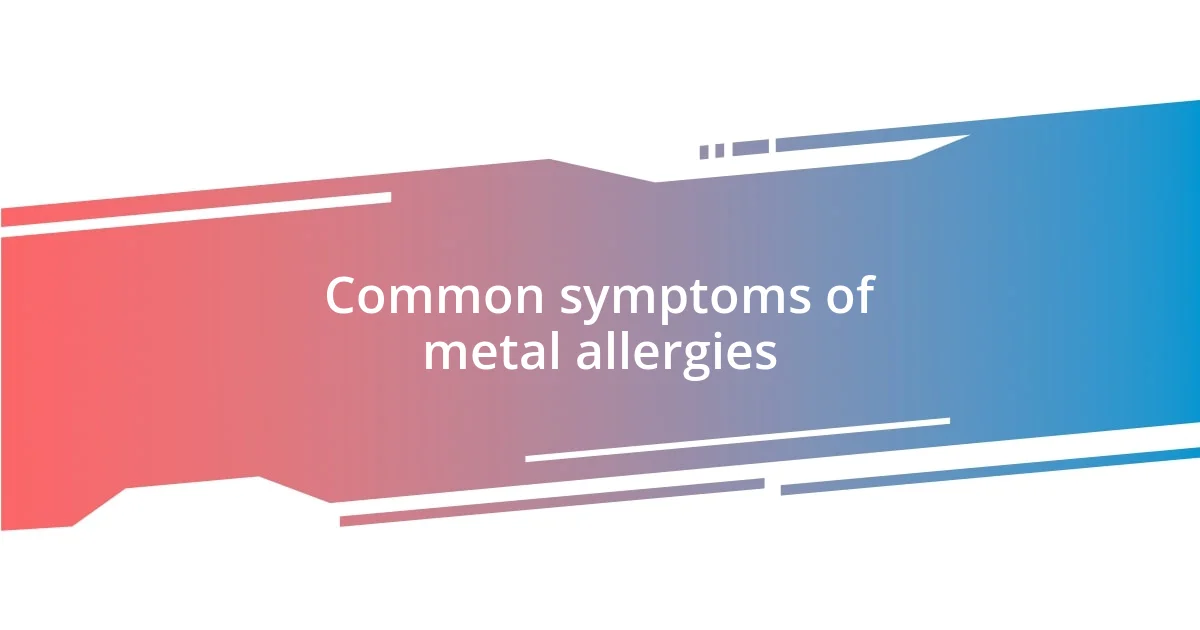Key takeaways:
- Metal allergies can arise unexpectedly, often from common items like jewelry and clothing fasteners, with symptoms including redness, itching, and dermatitis.
- Identifying triggers involves careful observation and can include tracking reactions to everyday items, prompting proactive avoidance of allergens.
- Effective management includes topical treatments, wearing hypoallergenic materials, and making lifestyle adjustments to limit metal contact.

Understanding metal allergies
Metal allergies can often catch us off guard, unlike typical environmental allergies. I remember the first time I noticed my skin reacting to a pair of earrings; I felt a mix of confusion and frustration. It was a reminder that even the materials we consider benign can pose unexpected challenges.
Have you ever wondered why some metals irritate people while others don’t? For instance, nickel is a common culprit, often lurking in everyday items like jewelry and even some clothing fasteners. I learned the hard way that what seems like a minor contact can result in a week of itching and discomfort, making me rethink my choices and stay vigilant about what I wear.
It’s fascinating to think about how our bodies respond to different materials. I can’t help but feel a little betrayed by metals that I once thought were harmless. Understanding that metal allergies are essentially a miscommunication between our immune system and the metal itself brings an interesting perspective. It truly emphasizes the importance of listening to our bodies and recognizing when something doesn’t feel right.

Common symptoms of metal allergies
When I first experienced a rash after wearing a bracelet, I was shocked. It wasn’t just a nuisance; it felt like an invasion of my skin. Common symptoms of metal allergies can vary, but many people, including myself, notice issues like redness, swelling, and intense itching. These reactions can crop up anywhere the metal contacts the skin, often leading to discomfort that is hard to ignore.
Some symptoms to watch for include:
- Red, inflamed patches of skin
- Itching or burning sensations
- Blistering or dry patches
- Swelling around the area
- Dermatitis or eczema flare-ups
It’s not just about the physical symptoms, either. There’s a real emotional impact, as I felt self-conscious about the rashes on my wrists. I’ve learned to be extra cautious about accessories since it turns this personal expression into a potential discomfort zone. Understanding these symptoms helps me, and hopefully you, become more aware of our body’s signals.

Identifying triggers in daily life
Identifying triggers in daily life involves careful observation of what we come into contact with regularly. I recall a time when I thought my reactions were spontaneous, only to realize that the metal components in my favorite belt buckle were triggering my discomfort. This experience taught me to examine not only jewelry but also everyday items like watches and buttons. It’s surprising how many things contain allergens without us even realizing.
In my journey to pinpoint triggers, I began keeping a diary to track my reactions. This effort unveiled patterns I would have otherwise missed. I noticed that every time I wore my go-to handbag, I experienced irritation where the metal clasp touched my skin. Reflecting on these encounters has helped me understand that awareness is crucial, and now, I’m more proactive in avoiding potential sources of irritation.
To further assist in identifying triggers, I often compare items I want to wear, focusing on their metal content. It’s been a game-changer for me; instead of reaching for a piece that may cause a reaction, I can confidently choose alternatives that are safe for my skin. This approach not only alleviates discomfort but also allows me to express my style without hesitation.
| Item | Potential Trigger |
|---|---|
| Earrings | Nickel |
| Bracelets | Copper |
| Watches | Stainless Steel |
| Belt Buckles | Alloy Metals |
| Handbags | Metal Clasps |

Testing for metal allergies
When I first suspected a metal allergy, I knew that finding the right test was crucial. I opted for patch testing, where small amounts of different metals are applied to my skin under a bandage. After a couple of days, I discovered the specific metals I needed to avoid, including nickel—something I had never considered could be a culprit before.
I remember going into the dermatologist’s office, feeling a mix of anxiety and hope. The process may sound straightforward, but it felt like a pivotal moment in understanding my body better. Seeing the results illuminated my past experiences, and suddenly, pieces of my discomfort began to align. Have you ever experienced something similar, where the answer was right in front of you all along?
Interestingly, this testing experience didn’t just help me with jewelry; it expanded my awareness of various products in my daily life. I found myself examining labels on metal items I had previously taken for granted. Each doctor’s visit became a stepping stone towards comprehending my sensitivities. I realized that understanding my allergies was liberating—not just a source of frustration but a chance to embrace my preferences healthily.

Treatment options for metal allergies
Treatment options for metal allergies can be quite varied, depending on the severity of the reactions and the specific metals involved. From my experience, topical treatments often become the first line of defense. I remember dealing with inflammation caused by a sneaky metal in a pair of earrings I loved, and applying a corticosteroid cream helped reduce the irritation significantly. Have you ever tried a topical option? It can be surprisingly effective and is often just a visit to the pharmacy away.
For those with more severe reactions, oral antihistamines may provide relief, especially if you’re experiencing itching or swelling. I was once caught in a situation where the irritation from a metal watch band spiraled into a full-blown allergic reaction. Taking an antihistamine helped me feel more comfortable until I could remove the offending item. It’s an option worth considering when metal allergies strike unexpectedly.
Ultimately, avoidance is key, and sometimes, that means wearing hypoallergenic alternatives made from titanium, surgical-grade stainless steel, or other non-reactive materials. I’ve invested in a few pieces, and the relief from wearing items that don’t cause discomfort is truly liberating. How about you? Finding styles that suit you while keeping your allergies in check can be an exciting journey, allowing you to embrace fashion and comfort simultaneously.

Preventive measures for metal contact
When it comes to preventing metal contact, I always find it helpful to develop a habit of checking labels. For instance, when selecting new clothing or accessories, I now make a point to look for metal components, especially in zippers and clasps. The first time I carefully scrutinized a belt buckle before purchasing, it felt empowering; I was taking charge of my own comfort and wellbeing.
I also keep a small kit with hypoallergenic alternatives—this has been a game-changer for me. Once, I had my eye on a stunning pair of earrings, but the material was questionable. Instead of giving in, I swapped out the hooks with surgical steel ones I had on hand. This little adjustment made all the difference, allowing me to enjoy them without fears of an allergic reaction.
Being mindful in my daily choices doesn’t just apply to accessories; it extends to household items as well. When I noticed a metal chair at a friend’s place caused irritation on my skin, I explained my metal allergy and sat elsewhere. It may feel awkward at first to address these sensitivities, but I’ve learned that open communication is essential. Have you ever found yourself in a situation where being upfront about your allergies reshaped your experience? It’s about creating safer environments for ourselves, and it’s okay to have those conversations!

Lifestyle adjustments for managing allergies
Adjusting my lifestyle to manage metal allergies has been a transformative experience. For example, I started wearing gloves when jewelry shopping or handling metal items, which might seem excessive to some, but for me, it’s a proactive measure that protects my skin. Have you ever thought about how little changes can help you maintain your comfort? It’s all about finding solutions that fit seamlessly into your day-to-day life.
Since I opted for a metal-free home environment, I noticed an incredible difference in my overall well-being. Swapping standard metal cookware for ceramic or stainless steel not only reduced my reactions but also encouraged me to cook more. There’s something rewarding about preparing meals in an allergy-friendly kitchen—it feels like I’m putting my health first. What adjustments have you considered making at home?
I’ve also learned to simplify my wardrobe by selecting clothing with minimal metal fastenings. This means prioritizing items with fabric buttons or magnetic closures. I remember once finding a stylish jacket that looked perfect, but I hesitated because of the metal zipper. By choosing garments thoughtfully, I’ve integrated my personal style with my health needs. Have you ever felt that thrill when you discover a new favorite piece that aligns with both your taste and your comfort? It’s truly a win-win!















